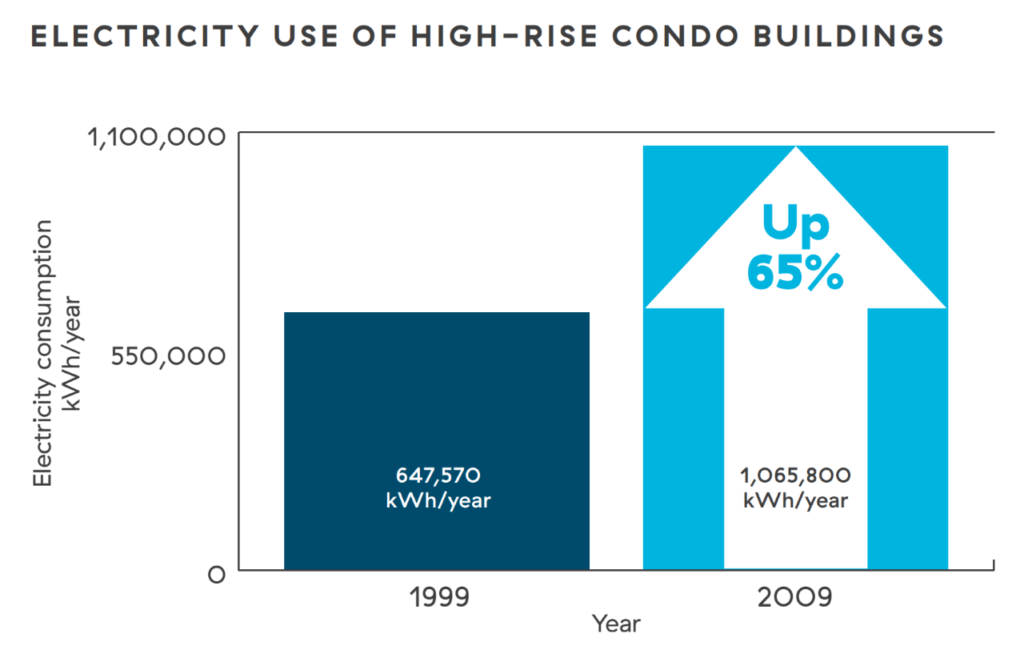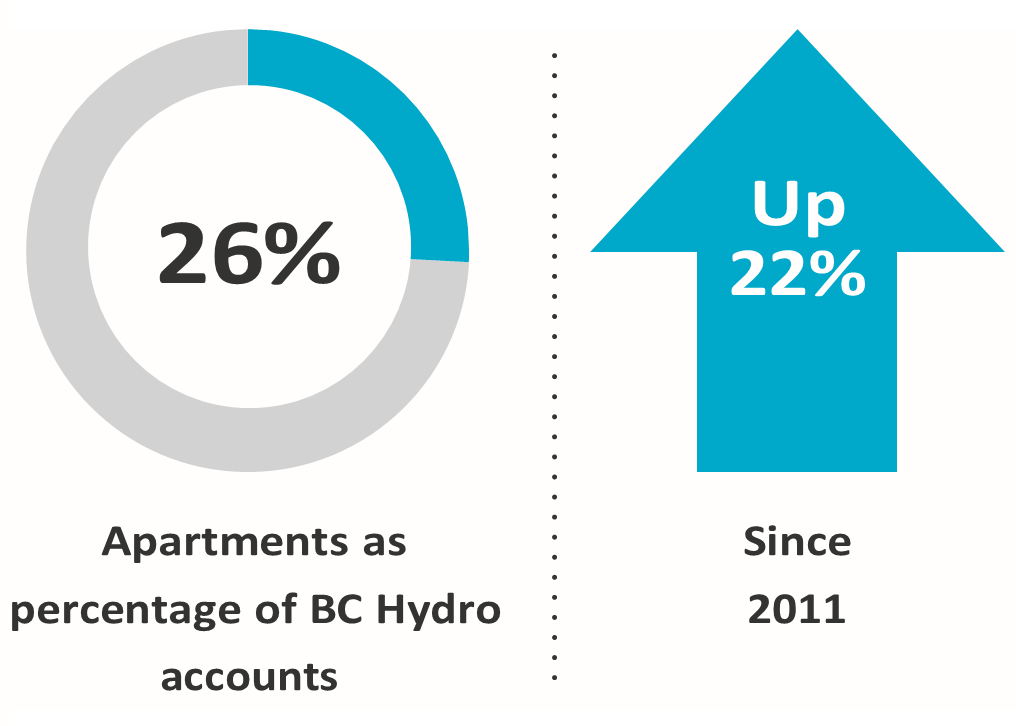Saturday June 1st… Dear Diary. The main purpose of this ongoing post will be to track United States extreme or record temperatures related to climate change. Any reports I see of ETs will be listed below the main topic of the day. I’ll refer to extreme or record temperatures as ETs (not extraterrestrials)😉
We Are Not Conserving Energy…Case In Point The Condo
I know I know. You personally, if having a conscience on environmental issues, are conserving energy via such measures as switching out incandescent light bulbs, using mass transit, or purchasing a hybrid or electric car. This is not the case for most of your neighbors, though. Our species as a whole continues to gobble up energy at a frightening pace as people planet wide increasingly want to enjoy luxurious creature comforts around the home. For today’s main subject let’s take the case of the newer condominium, which most would think conserves more energy than individual houses due to higher and more uniform building standards. Unfortunately, one study shows that compared to older condos, this is not necessarily so:
Here is some of that post:
Desdemona Despair
May 28, 2019
Luxury condo buildings sucking twice as much power as older ones – “There seems to be a disconnect between what their perceived energy footprint is and what their actual energy footprint is by living in one of these high-rises
By Sean Boynton
12 April 2019
(Global News) – If you live in a newly-built luxury condo building, you may be enjoying some of the perks being offered: swimming pools, fitness centres, even movie theatres and bowling alleys.
But a new report from BC Hydro says those amenities come at a cost — and it could nearly double your hydro bill, despite the buildings being advertised as energy-efficient.
“The average bill of someone living in a condo or apartment in B.C. is about $40 a month,” BC Hydro spokesperson Tanya Fish said.
“If they were to pay for all the electricity used by these extra amenities and common spaces, it would [cost] about an additional $40 a month in electricity costs to their bill.”
Condo dwellers are still seeing those costs, however, in the form of strata fees.
The report released Friday found the energy drawn from everything outside individual suites in these newer buildings accounts for half of these newer buildings’ electricity use. That’s compared to condo buildings built in the 1980s, whose common spaces accounted for 25 per cent.

Electricity use of high-rise condo buildings in 1999 and 2009. BC Hydro data shows the amount of electricity used in condo buildings is also on the rise, nearly doubling since the 1980s, with the largest period of growth between 1999 and 2009 when the average electricity consumption of a newly-built condo building grew by 65 percent. Graphic: BC Hydro
The buildings studied were largely erected between 2011 and 2017. […]
“There seems to be a disconnect between what their perceived energy footprint is and what their actual energy footprint is by living in one of these high-rises,” she said. […]
Gioventu said another problem is the energy use in condos themselves, with more owners buying interior air conditioners, fans and heaters to combat an ever-changing climate.
“When you have buildings that are all glass, there’s no place to mount external air conditioning units or heat pumps,” he said. “So a lot of these buildings don’t have these systems in place at all.” [more]
Luxury condo buildings sucking twice as much power as older ones, BC Hydro says

Apartments as a percentage of BC Hydro accounts are up 22 percent since 2011. Graphic: BC Hydro
VANCOUVER, 12 April 2019 (BC Hydro) – Despite many new, high-end condo buildings being marketed as being energy-efficient, British Columbians living in them have a much larger energy footprint than those living in older condos and apartments – regardless of what they may think.
A new BC Hydro report titled High-powered high-rise: The energy footprint disconnect of B.C.’s high-end condo dwellers [PDF, 211 KB] found that while condo living means smaller homes that use less power than detached single-family homes, this does not necessarily represent the total energy footprint of living in a high-rise condo building. New BC Hydro data shows that the amount of electricity used in condos has nearly doubled since the 1980s, with the largest period of growth between 1999 and 2009 when the average newly built high-rise building’s electricity consumption increased by 65 per cent. This is likely due to the addition of more luxurious amenities like heated pools, hot tubs, saunas, fitness centres and movie theatres.
High housing prices have led more British Columbians to purchase condos over townhomes or single-family detached homes. In fact, BC Hydro has seen a 22 per cent increase in the number of condo and apartment accounts since 2011 – and they now represent nearly half a million accounts in total. With sales, and construction of high-rise buildings increasing, so is the amount of power being used. High-rise luxury buildings consume about three to four times more electricity than low-rise buildings.
While apartment and condo dwellers have average electricity bills that are about 50 per cent lower than those in the average single-family home, these lower bills do not provide an accurate picture of their electricity use. Despite the suites in newer high-rise buildings often being marketed as energy-efficient and including things like LED lighting and ENERGY STAR® appliances, the combined electricity usage of the overall building is approximately two times more than high-rises built in the 1980s. They also use almost four times more electricity than low-rise buildings built that same decade.
Fifty per cent of a high-end condo’s electricity use goes to powering all of the things outside of the individual suites. This includes the energy required to power the luxury amenities as well as the energy required to run the elevators, light the lobby, hallways and parking garage, plus operate the heating and cooling systems, all day, every day.
If this cost appeared on a condo dwellers’ electricity bill, it would add about $40 a month – nearly doubling the average bill of $43 dollars a month. And bringing it very close to the average single-family home’s bill at $103 per month.
Although energy efficiency might not be at the top of the list for an upscale condo buyer, the more energy efficient a building is, the more comfortable it will be for the tenants and the lower its operating costs will be. BC Hydro recommends:
- Adding occupancy sensors: this ensures lights are only on when a space is occupied, which can help reduce wasted electricity by up to 30 per cent.
- Lighting upgrades: switching to energy-efficient lighting can improve lighting costs by up to 40 per cent and also cut down on cooling costs as there will be less heat output from lights.
- Automated controls for HVAC systems: these go a long way in improving the energy-efficiency of a building’s heating and cooling systems reducing energy consumption by approximately 30 per cent.
For more information, visit powersmart.ca.
Report: Luxury high-rise condos are guzzling electricity
If you wish to upgrade to a new condo or apartment do some homework. Ask what energy saving methods are in place for each unit as described in this highlighted article. Ideally in the future condo high rises or smaller condo buildings will have solar panels on roofs, but unfortunately nearly all don’t as of 2019. Perhaps in the future dwelling energy use standards will be in place, but these may not come to pass until the climate crisis is well out of hand I fear.
………………………………………………………………………………………………………
Here is some more climate and weather news from Saturday:
(As usual, this will be a fluid post in which more information gets added during the day as it crosses my radar, crediting all who have put it on-line. Items will be archived on this site for posterity. In most instances click on the pictures of each tweet to see each article.)
(If you like these posts and my work please contribute via the PayPal widget, which has recently been added to this site. Thanks in advance for any support.)
The Climate Guy
Guy,
Have you ever seen any work on how our personal savings contribute to emissions? Does money = emissions? Many of us put our retirement money into 401k’s or some some other investment fund. So we own the very businesses that our destroying our world? We put our money into local banks, and I assume that money is loaned out by other people to buy cars, or condos etc. We try to make a low carbon investment, but that money keeps moving in the economy supporting the very economic system that will destroy us all.
I guess, I’m looking for a good exploration of finance and emissions, and if there is any way out of our predicament with out the total collapse and replacement of capitalism as it’s currently practiced. Any help would be appreciated.
Bentley, you pose an interesting question.
I’ll have to research this one for awhile.
Yes, capitalism in its purest form will not work well at all to solve the climate crisis,
Guy